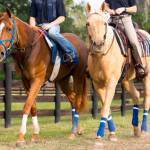Calming Forces: Social Buffering Among Horses

In the complex world of animal behavior, social buffering describes the phenomenon in which the presence of an animal, or group of animals, can reduce or eliminate the stress response of another individual when exposed to stressful stimuli. This phenomenon has been observed between dams and offspring and between mature animals. Researchers at the University of Lincoln, in the United Kingdom, evaluated stress response and social buffering of paired horses in a two-pronged study, with the primary difference being familiarity between horses.
All of the horses used in the studies were employed as school horses and were of different breeds, ages, and sexes. In the first study, researchers divided thirty-two horses into pairs. The horses in each pair were familiar with one another, as they had been housed together for over a year. In this context, researchers defined familiarity as recognition of another animal based on distinctive characteristics, not necessarily a social bond. In the second study, 32 horses were placed in pairs, though the horses in each pair were not known to each other.
Researchers habituated all horses to the testing area prior to the study to relieve any stress that accompanies a new environment. One horse of each pair was then habituated to the test stimuli, in this case the appearance of a striped ball (a novel, unchanging stimulus) and an opening umbrella (a novel, suddenly changing stimulus), both of which happened directly in front of the horse. The same habituated horses were used in both studies. Heart rate was measured during the tests.
In these studies, researchers found that social buffering was influenced by the particular stimulus presented but not by the companion’s familiarity or habituation status. Any companion, either a familiar or an unfamiliar one, reduced the behavioral response to the ball but not the umbrella. The researchers theorized that the “immediacy and mental focus of the startle response meant the behavioral reaction [to the umbrella test] was not susceptible to social buffering.” Of interest, heart rate recovered more quickly for horses after the umbrella test than after the ball test, which suggests social buffering may be triggered after the initial reaction.
Knowledgeable horsemen often couple older, wiser horses with inexperienced ones in new situations. Imagine the stoic, sure-footed horse that confidently leads another on a trail ride, or the revered campaigner that hauls comfortably and uncomplainingly next to a nervous traveler. These too might be instances of social buffering. When horses are presented with a new situation, it is best to have them physically as well as mentally prepared for the task ahead. From a nutritional perspective, this means protecting their gastrointestinal tract against the physical effects of stress, like gastric ulcers and hindgut acidosis, with research-proven digestive supplements.
*Ricci-Bonot, C., T. Romero, C. Nicol, and D. Mills. 2021. Social buffering in horses is influenced by context but not by familiarity and habituation of a companion. Scientific Reports 11:8862.








